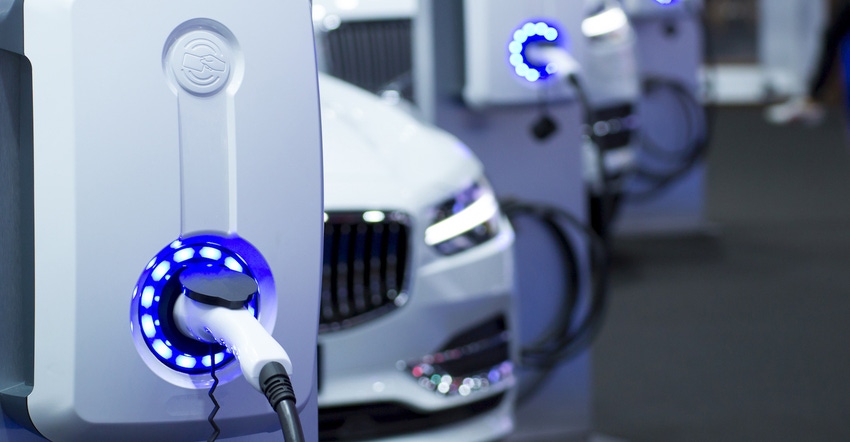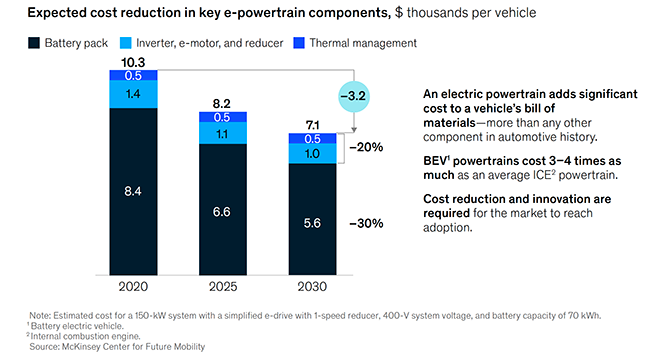Thermal management and enclosures for EV batteries have been identified as applications ripe for growth.
August 16, 2022

A recent forecast by the McKinsey Center for Future Mobility predicts that battery electric vehicles (BEVs) and plug-in hybrid electric vehicles (PHEVs) will make up more than 55% of new vehicle production across China, Europe, and North America by 2030. This represents 47 million units globally — seven times more than in 2021.
Adoption has moved beyond startups, with all mainstream OEMs now focused on electric vehicles (EVs) and with forecasts for EV penetration continuing to accelerate. More than 500 EV programs will come to market from 2024 to 2026 alone. In short, tomorrow’s vehicle architecture is being defined today, offering a narrow window of opportunity for chemical and plastic companies to set the standard for materials applications in the years to come, according to McKinsey.
Shift to system-value approach for plastics
Although EVs have been a hot topic in the plastic and chemical industries for some time, a major paradigm shift in automotive procurement practices has made the space dramatically more attractive for suppliers of various materials (not considering cell chemistry, a market governed by unique value chain dynamics). Whereas chemicals and, by definition, plastics in the automotive industry were traditionally considered on a unit-cost basis — with suppliers barely able to hold value over the program’s life cycle — savvy automotive OEMs and tier suppliers are now moving to a system-value approach. These players recognize that materials solutions can provide outsize value in reducing cost and improving the reliability of expensive parts, such as batteries, power electronics, and electric motors.
|
To illustrate this point, McKinsey considers the powertrain of a typical BEV. The battery, inverter, and electric motor together cost more than $10,000 — often three to four times the cost of their equivalent parts in a conventional internal combustion engine vehicle. Hence, the vehicle system must come down in cost for BEVs to gain widespread adoption.
In this context, leading OEMs have discovered that using the right thermal and insulation materials, which only account for around 5% of overall e-drivetrain cost, in the powertrain can lead to significant increases in system efficiency and reductions in warranty cost. Together, they can represent several hundred dollars per vehicle. These savings make it much easier for OEMs to invest in enabling these materials.
It is no secret that battery costs need to drop dramatically for EVs to become cost efficient, and that battery safety is paramount. Although most discourse seems to be focused on the chemistry and supply/demand balance of battery cell materials, many progressive OEMs have recognized that plastics, silicones, mica, and other thermal materials can be engineered together to significantly reduce system costs.
Event highlights battery opportunities for composites
The SPE Automotive Composites Conference & Expo (ACCE) slated for September 7 to 9, 2022, at the Suburban Collection Showplace in Novi, MI, will highlight the importance of plastics-based solutions in EV batteries via one of the keynote presentations: Opportunities for Composite Materials in Future Multi-Material Battery Enclosures by Warden Schijve, Design Leader at AZL Aachen GmbH.
Schijve led a one-year consortium project at AZL Aachen with 46 participating companies on multi-material battery casing designs. It yielded 20 different concept designs that were CAE analyzed to all relevant load cases and compared on a cost and weight basis with a state-of-the-art metal (welded aluminum) design. The keynote presentation will highlight project results, including analysis and comparisons of both thermoset and thermoplastic materials; solid laminate and sandwich solutions; short fiber over-molded solutions; various SMC options; steel; aluminum; and combinations of all these materials.
All relevant load cases were considered in the CAE analysis, as defined by safety regulations, in combination with specific OEM requirements. In total, “20 different multi-material concepts were optimized on weight and cost and compared to the aluminum battery enclosure design,” said Schijve. “All production steps were cost-modeled in detail to obtain reliable cost estimates for each variant. As a result, each battery enclosure concept, including composite materials, resulted in different weight savings up to 36% and cost savings up to approximately 20%, in comparison to the aluminum design,” said Schijve.
About the Author(s)
You May Also Like





